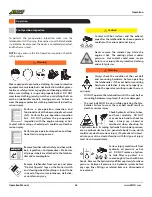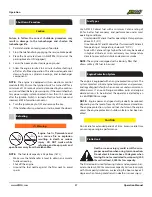
Operation Manual
53
www.XMFG.com
Operation
other telehandler, make sure the two (2) telehandlers
are not touching.
•
DO NOT allow jump start cable ends to contact each
other.
•
Connect charged battery positive (+) to stalled battery
positive (+).
•
Connect charged battery negative (–) to stalled fork-
lift ground. Make the connection to the stalled forklift
ground last.
•
Connect jump start cable to stalled forklift ground a
safe distance from the battery to prevent sparks near
the battery.
Jump Starting
Jump Start or replace the battery of the telehandler when
the battery is discharged to the point that it will not crank the
starter.
Lead-acid batteries produce flammable and potentially ex-
plosive gases. To avoid death or serious injury when check-
ing, testing, or charging batteries:
•
DO NOT use smoking materials near batteries.
•
Keep arcs, sparks, and open flames away from batteries.
•
Provide ventilation for flammable vapors.
•
Wear proper personal protective equipment, including
safety glasses.
Fluid in electric storage batteries contains sulfuric acid,
which is poison and could cause severe chemical burns.
Avoid all contact of fluid with eyes, skin, or clothing. Use
protective gear when handling batteries. DO NOT tip a bat-
tery beyond a 45° angle in any direction.
If contact does occur, follow these First Aid suggestions:
•
External contact
- Flush with water.
•
Eyes
- Flush with water (including under the eyelids) for
at least 15 minutes and get medical attention immedi-
ately. Flushing must begin immediately to avoid per-
manent eye tissue damage.
•
Internal contact
- Drink large quantities of water or milk
to dilute stomach contents. Do not induce vomiting.
Get medical attention immediately.
IMPORTANT - In case of internal contact, DO NOT give fluids
that induce vomiting.
Warning
Warning
Wear eye protection when starting a
telehandler with jump start cables. Improper
jump start procedures could cause the
battery to explode, which could result in
death or serious injury.
•
Never jump start a frozen battery, as it can explode. Let
the battery thaw out before charging.
•
NEVER jump start the telehandler when travel select le-
ver is in gear, which can cause the telehandler to lurch
forward or backward, and could result in death, serious
injury, or property damage.
•
To avoid injury or death when jump starting with an-
When installing and removing jump start ca-
ble, ensure loose ends of cable do not come
in contact with each other, with any metal
surfaces or personnel. Failure to comply may
result in injury or death to personnel.
Warning
•
Position booster vehicle so that the battery box is close
to disabled vehicle’s battery box.
•
Remove battery cover.
•
Connect jump start cable to booster battery; Black to (-)
battery post and Red to (+) battery post .
•
Connect the other end of jump start cable to disabled
vehicle’s battery Black to (-) post, Red to (+) battery post.
•
Raise booster vehicle just above idle.
•
Start disabled vehicle.
•
Return booster vehicle to idle.
•
Remove jump start cable from both vehicles.
•
Reinstall the battery cover on both vehicles.
1. Position booster vehicle with the NATO slave receptacle
(Figure 3) close to disabled vehicle NATO receptacle (A).
2. Remove cover from NATO slave receptacle (A).
3. Connect slave cable to receptacle.
4. Connect other end of slave cable to disabled vehicle.
5. Raise booster vehicle just above idle.
6. Start disabled vehicle.
7. Return booster vehicle to idle.
8. Remove slave cable from booster and disabled vehicles.
9. Reinstall the cover over the NATO slave receptacle (A).
Jump Starting With Optional NATO Slave Receptacle
The machine may be equipped with an optional NATO slave
receptacle to facilitate the vehicle-to-vehicle jump starting. In
this case, the jump starting procedure is described below:





































